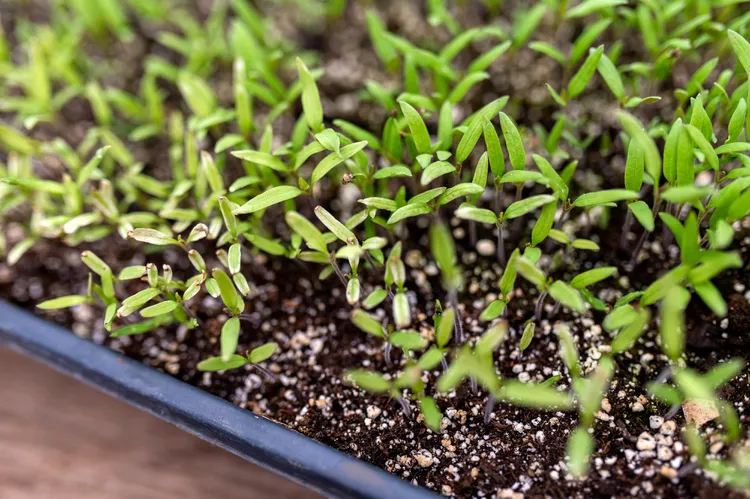Damping off is a common plant disease that affects seed germination rates and can cause entire flats of newly sprouted seedlings to rapidly wither and die. Both vegetable and flowering plants are susceptible to damping off, and infected plants cannot be cured. While combating plant diseases can be challenging, there are several ways to prevent damping off in seedlings. This guide will walk you through what you need to know to keep your sprouting seedlings healthy.
What Is Damping Off?
Damping off disease is caused by several types of fungi, including Pythium, Botrytis, and Fusarium, which naturally occur in soils and are particularly prevalent in cool, moist conditions. These plant pathogens are common in outdoor gardens, but they can also creep indoors and infect potting mixes. Seedlings are most vulnerable to damping off spores immediately after they germinate, and plants become more resistant after their true leaves appear.
Damping Off Disease Symptoms
If you’ve ever had a flat of seedlings wilt rapidly even though they were watered correctly, you’ve likely encountered damping off. Although damping off is common, the symptoms vary significantly because several types of fungi cause it.
Some of the most common signs you may be dealing with damping off include:
- Seeds don’t germinate.
- Seedlings rapidly die or wither.
- Seedling stems look shriveled and thin or like they’ve been pinched off at the soil line and collapsed.
- Seedling leaves are mushy, discolored, or wilted, even when they receive enough water.
- Seedlings have stunted or absent roots.
- Cobweb-like mold develops on seedlings and the soil line. (Not to be confused with seedling root hairs, which are normal.)
If your seedlings succumb to damping off disease, isolate and dispose of the infected seedlings immediately. Don’t compost any infected plant material or potting mixes, because damping off spores can survive the composting process.
Tips for Preventing Damping Off
Damping off isn’t curable, so the best thing to do is focus on prevention. These growing tips will help you protect indoor and outdoor seedlings from damping off.
1. Disinfect plant pots and trays.
If you start seedlings indoors, disinfect any seedling-growing trays, trowels, humidity domes, plant labels, and other supplies if you used them during previous growing seasons. These supplies can sometimes harbor damping off spores, which can infect new seeds after you sow them. Disinfect the supplies by spraying or wiping them with rubbing alcohol and letting them dry or soaking them in a 10% bleach solution for 30 minutes.
2. Use fresh seed-starting mix.
Old potting mixes can sometimes be infected with damping off disease and should never be reused for seed starting. Instead, use fresh seed-starting mix and steer clear of regular potting mix or garden soil for indoor seeds. Standard potting mixes and garden soil don’t drain as well as seed-starting mixes, and garden soil may contain damping off spores.
3. Add a fan.
Damping off thrives in cool, moist conditions with stagnant air, and it’s particularly prevalent in closed-up growing rooms with poor airflow. However, adding a small fan to the space can boost air circulation and keep seedlings healthy. Also, don’t forget to remove humidity domes after seedlings sprout.
4. Don’t overwater.
Overwatering and soggy soil also encourage damping off, but they can be avoided by following proper watering guidelines. Start seeds in well-draining pots and only water seedlings when the top of the soil feels slightly dry to the touch. For even better results, water seedling trays from the bottom to keep plant leaves dry.
5. Use grow lights and a heat mat.
Damping off is more likely to occur in slow-growing seeds that take a while to germinate, while fast-growing seeds tend to be more resistant. One way to speed up germination is to use grow lights for 12 to 16 hours a day. Another option is to keep seedling trays on heating mats, but remember to turn the mats off after the seeds sprout.
6. Experiment with soil amendments.
Studies have found that certain soil amendments, like worm castings and biochar, can protect seedlings from damping off. Adding some of these amendments to seed-starting mixes can give your seedlings an advantage.
7. Thin out seedlings.
Overcrowded seedlings can become stressed and are more prone to damping off due to poor air circulation. Keep seedlings healthy by thinning them out (if needed) after they’re a few inches tall and have at least two sets of true leaves.
8. Plant outdoor seedlings at the right time.
Waiting to plant seeds in spring can be difficult, but planting seeds outdoors too early increases the chances of damping off. Most seeds germinate faster in warm soil; seeds planted outside too early are slower to germinate and more vulnerable to damping off. Seed packets typically state when and how to plant seeds; following these instructions will boost seed germination rates and help you grow healthier seedlings.

